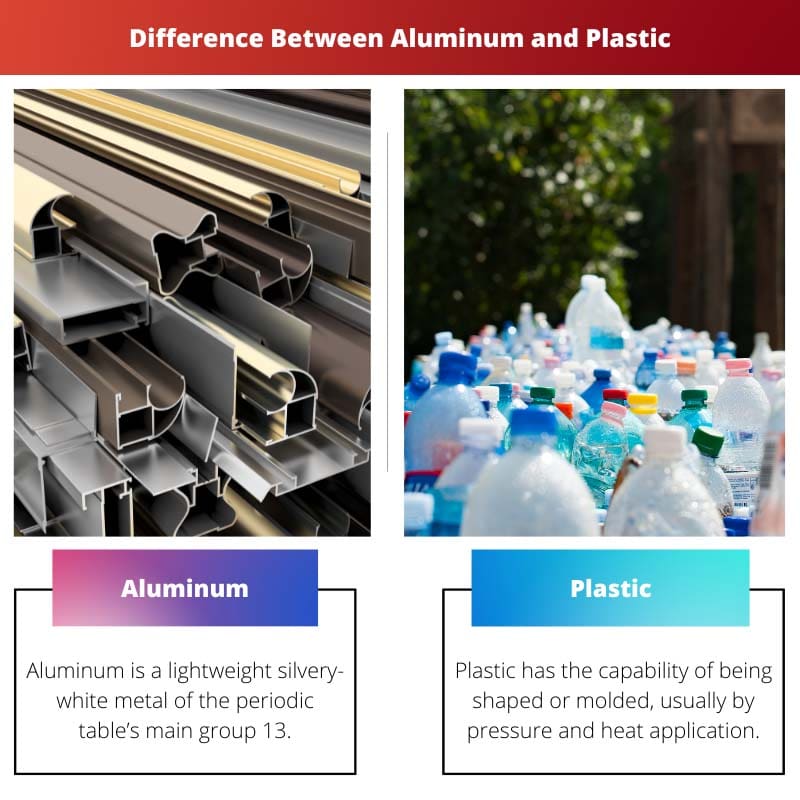Lamps, decorative panels, tables, picture frames, toys, luggage, trash bags, traffic cones are some of the products used in daily life.
They are manufactured from either aluminum or plastic and that’s why it can be said that the usage of both aluminum and plastic in our day-to-day life is increasing.
In the earth’s crust, aluminum is the third most abundant thing.
In the earth, aluminum is found along with potassium, calcium, and iron and thus not found alone. On the other hand, organic molecules play a major role in plastic manufacturing.
In this article, the chief aim is on differentiating aluminum and plastic.
Key Takeaways
- Aluminum is a lightweight, strong, and recyclable metal used in various applications, such as the automotive, aerospace, and packaging industries.
- Plastic is a synthetic material made from polymers, used in numerous products due to its versatility, low cost, and moldability.
- Aluminum has a higher heat resistance and strength than plastic, but plastic is easier to process and can be tailored to specific properties.
Aluminum vs Plastic
Aluminum is a lightweight, corrosion-resistant, metallic material that’s good for structural applications. Plastic is a non-metallic, lighter material, that’s used where corrosion resistance and insulation are required, but it’s less structurally sound.

Aluminum is a lightweight silvery-white metal of the periodic table’s main group 13. Due to its chemical activity, it never occurs in nature in metallic form.
Meanwhile, its compound is present to a lesser or greater extent in almost all vegetation, animals, and rocks.
Plastic has the capability of being shaped or molded, by pressure and heat application. Many of the polymer’s chemical names are employed as plastic and become familiar to consumers.
Meanwhile, some are better known by their trade names like polymethyl methacrylate and abbreviations like PET.
Comparison Table
| Parameters of Comparison | Aluminum | Plastic |
|---|---|---|
| Discovery | Hans Christian Orsted (1824) | Leo Baekeland (1907) |
| Appearance | Silvery gray metallic | High-gloss (smooth and shiny) |
| Durability | More | Less |
| Conductivity | Good conductor | Poor conductor |
| Melting point | Approx 1220°F | Between 160-210°C |
What is Aluminum?
Aluminum has a huge affinity to oxygen, and on the surface, forms are oxide’s protective layer when exposed to the layer. It visually resembles silver in its ability to reflect light and color.
Chemically, in the boron group aluminum is a post-transition metal and forms compounds chiefly in the +3 oxidation state.
The aluminum’s production starts with the bauxite rock’s extraction from the ground. With the help of the Bayer Process, the bauxite is processed and transformed into alumina.
Further, using the Hall-Heroult process it is then processed and resulting in the final metal of aluminum.
Metal recovery by recycling has set off a vital duty of the aluminum industry. It comprises melting the scrap and requires energy only approx 5% to create aluminum from one.
The melter of aluminum stack generates less dross, with merit reported below 1%.
Near mining sites, higher levels of aluminum occur; aluminum in small amounts is released to the incinerators or power plants of coal-fired.
By the rain, aluminum present in the air is cleansed out or commonly settled down, whereas aluminum’s small particles endure for a long time in the air.

What is Plastic?
Plastic is an extent of semi-synthetic or synthetic materials that use the main substance of polymers. Through fossil fuel-based chemicals viz. petroleum or natural gas, the most modern plastics are derived.
Current industrial methods utilize variants constructed from renewable substances like cotton or corn derivatives.
In developed economies, the utilization of plastic is around a third in packaging and about the same in applications such as plumbing, pumping, or vinyl siding. Other users consist of toys, furniture, and up to 20% plastic in automobiles.
The plastic applications might differ in the world which is developing.
A fully synthetic plastic namely, Bakelite, was the first in the world.
Today, dozens of distinctive kinds of plastic are produced like polyethylene (used in Polyvinyl chloride and product packaging) used in pipes and construction because of its durability as well as strength.
Several chemists contributed to the science of plastic substances involving Herman Mark as well as Nobel laureate Hermann Staudinger.
The dominance and success of plastics kick off in the early 20th century led to extensive environmental problems because in natural ecosystems their decomposition rate is slow.
To ease environmental concerns, the plastics industry promoted recycling at the end of the 20th century while steady to produce virgin plastic.

Main Differences Between Aluminum and Plastic
- In terms of environmental aspects, it is easier to recycle aluminum and less dangerous than plastic. On the contrary, plastic is hard to recycle because it fails to degrade or decompose. Thus, plastic is more dangerous compared to aluminum.
- The impact of weather conditions on aluminum is more than plastic, and that’s why it has a shorter life. Meanwhile, on plastic, there is no impact of changing weather conditions and also does not rot. So, plastic products have a longer life compared to the aluminum product.
- The aluminum can be used in a range of products like foils, beer keys, kitchen utensils, cars, airplane parts, and many more. On the other hand, plastic can be used in building and construction, transportation, to produce packages, industrial machinery, etc.
- When it comes to advantages, lightweight, odorless, corrosion resistance, impermeable, thermal conductivity, and reflectivity are some of the advantages of aluminum. On the flip side, the advantages of plastic are extreme versatility, resistance to water and chemicals, hygiene properties, good safety for food packaging, etc.
- When comparing the strength of aluminum and plastic, aluminum is stronger compared to plastic. To strengthen the aluminum, there is no requirement for additional materials. In contrast, by fusing plastic with steel or glass it is made strong, but still plastic is not as strong as aluminum.

References
- https://acsess.onlinelibrary.wiley.com/doi/abs/10.2134/agronmonogr9.2.c16
- https://royalsocietypublishing.org/doi/abs/10.1098/rstb.2009.0054
